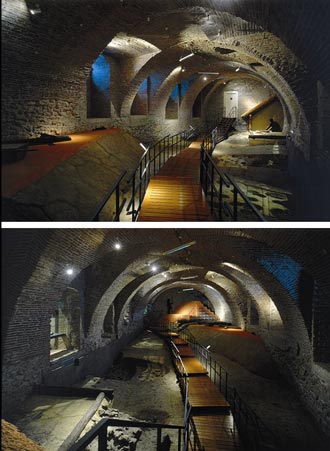Permanent Display 3. Finds at the Site of Discovery
 The presentation of a locality in situ, that is, the display of an archaeological site at the level and place of discovery, is determined by the museological conception of the permanent exhibition and the feasibility of conservation, to which it has to be adjusted. The part of the locality excavated in the eastern wing of the one - time convent, in which remains of a rampart and residential architecture from the Early Iron Age have been found, satisfied, in its significance, position and degree of preservation, all the conditions.
The presentation of a locality in situ, that is, the display of an archaeological site at the level and place of discovery, is determined by the museological conception of the permanent exhibition and the feasibility of conservation, to which it has to be adjusted. The part of the locality excavated in the eastern wing of the one - time convent, in which remains of a rampart and residential architecture from the Early Iron Age have been found, satisfied, in its significance, position and degree of preservation, all the conditions.
The discovery of the rampart and rampart structures, excavated in 1992, revealed enough data to make possible a detailed reconstruction of their size and manner of construction. For a reconstruction of the one time height of the rampart, the elevation of the recently discovered Romanesque entrance into the medieval castle on the eastern outer wall was used. The excavations have shown that the rampart was built of round logs placed cassette-wise; branches were arranged between the logs, and the whole was covered with compacted clay. Afterwards, the rampart was covered with branches, and the whole construction was set alight. When fired, the rampart construction was tougher and more resistant to the atmosphere. Through dendrochronological analysis of the age of wood (tree-ring counting) found in the construction of the rampart, the carbonised remains of a tree were dated to the year 679, the early Middle Ages; no other traces of this period have been found in this locality.
The best preserved building from the settlement uncovered in the archaeological excavations was the find of the remains of a metal-working workshop of the 1st century BC. The walls, of horizontally disposed logs, were reconstructed according to analogous central European finds of houses of the same period. Inside the workshop, the preserved part of the earth floor, and the oven and hearth for the thermal treatment of metals are shown.

Želimir Škoberne, Boris Mašić

